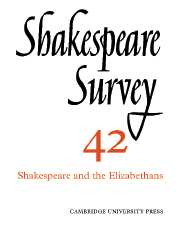Book contents
- Frontmatter
- ‘Jack hath not Jill’: Failed Courtship in Lyly and Shakespeare
- Truth and Art in History Plays
- Chronicles and Mythmaking in Shakespeare’s Joan of Arc
- King John and Embarrassing Women
- Golding’s Ovid, Shakespeare’s ‘Small Latin’, and the Real Object of Mockery in ‘Pyramus and Thisbe’
- Ovid and the Sonnets; or, did Shakespeare Feel the Anxiety of Influence?
- The Play of Sir Thomas More and Some Contemporary Events
- ‘Nobody’s Perfect’: Actors’ Memories and Shakespeare’s Plays of the 1590s
- The Boyhood of Shakespeare’s Heroines
- Shakespeare’s ‘Brawl Ridiculous’
- Shakespeare’s Handwriting
- Shakespeare Performances in England, 1987–8
- Professional Shakespeare Productions in the British Isles, January-December 1987
- The Year's Contributions to Shakespearian Study 1 Critical Studies
- 2 Shakespeare’s Life, Times, and Stage
- 3 Editions and Textual Studies
- Books Received
- Index
The Boyhood of Shakespeare’s Heroines
Published online by Cambridge University Press: 28 March 2007
- Frontmatter
- ‘Jack hath not Jill’: Failed Courtship in Lyly and Shakespeare
- Truth and Art in History Plays
- Chronicles and Mythmaking in Shakespeare’s Joan of Arc
- King John and Embarrassing Women
- Golding’s Ovid, Shakespeare’s ‘Small Latin’, and the Real Object of Mockery in ‘Pyramus and Thisbe’
- Ovid and the Sonnets; or, did Shakespeare Feel the Anxiety of Influence?
- The Play of Sir Thomas More and Some Contemporary Events
- ‘Nobody’s Perfect’: Actors’ Memories and Shakespeare’s Plays of the 1590s
- The Boyhood of Shakespeare’s Heroines
- Shakespeare’s ‘Brawl Ridiculous’
- Shakespeare’s Handwriting
- Shakespeare Performances in England, 1987–8
- Professional Shakespeare Productions in the British Isles, January-December 1987
- The Year's Contributions to Shakespearian Study 1 Critical Studies
- 2 Shakespeare’s Life, Times, and Stage
- 3 Editions and Textual Studies
- Books Received
- Index
Summary
Attempts at reconstructing the earliest performances of Shakespeare's plays are notoriously hit-and-miss affairs: nowhere more so than when we attempt to gauge the impact of male actors playing female roles. We are so used to reading the plays (or, when we see them, to seeing true-sex interpretations of the various character-parts) that we too easily set up our modern experience of the plays as the goal towards which an Elizabethan performance was tending. The present paper invites us to reconsider this presupposition.
Samuel Johnson's claim that theatre audiences 'are always in their senses, and know, from the first act to the last, that the stage is only a stage, and that the players are only players' is typical of its period. When they came to discuss the large matter of the relationship between artistic representation and the reality to which such representation alludes, eighteenth-century authors regularly displayed both a lively interest and a great deal of intelligence and good sense. Samuel Richardson, for example, wrote a tactful letter to William Warburton in which he rejected the bishop's proposed Preface to Clarissa on the grounds that it punctured the illusion of reality which he wished his novel to maintain. In the small space available to him he manages to do a large amount of justice to a complex matter: he indeed wishes 'that the Air of Genuiness had been kept up' in Warburton's Preface, but hurries on to admit that 'I want not the Letters to be thought genuine'; he wishes merely that they 'should not prefatically be owned not to be genuine', and this in order to 'avoid hurting that kind of Historical Faith which Fiction itself is generally read with, tho' we know it to be Fiction'.
- Type
- Chapter
- Information
- Shakespeare Survey , pp. 99 - 110Publisher: Cambridge University PressPrint publication year: 1990

